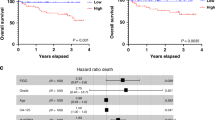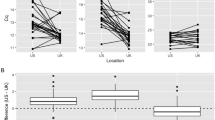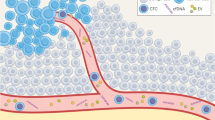Abstract
Background
The diagnosis of follicular thyroid carcinoma (FTC) prior to surgery remains a major challenge in the clinic.
Methods
This multicentre diagnostic study involved 41 and 150 age- and sex-matched patients in the training cohort and validation cohort, respectively. The diagnostic properties of circulating small extracellular vesicle (sEV)-associated and cell-free RNAs were compared by RNA sequencing in the training cohort. Subsequently, using a quantitative real-time polymerase chain reaction (qRT‒PCR) assay, high-quality candidates were identified to construct an RNA classifier for FTC and verified in the validation cohort. The parallel expression, stability and influence of the RNA classifier on surgical strategy were also investigated.
Results
The diagnostic properties of sEV long RNAs, cell-free long RNAs and sEV microRNAs (miRNAs) were comparable and superior to those of cell-free miRNAs in RNA sequencing. Given the clinical application, the circulating sEV miRNA (CirsEV-miR) classifier was developed from five miRNAs based on qRT‒PCR data, which could well identify FTC patients (area under curve [AUC] of 0.924 in the training cohort and 0.844 in the multicentre validation cohort). Further tests revealed that the CirsEV-miR score was significantly correlated with the tumour burden, and the levels of sEV miRNAs were also higher in sEVs from the FTC cell line, organoid and tissue. Additionally, circulating sEV miRNAs remained constant after different treatments, and the addition of the CirsEV-miR classifier as a biomarker improves the current surgical strategy.
Conclusions
The CirsEV-miR classifier could serve as a noninvasive, convenient, specific and stable auxiliary test to help diagnose FTC following ultrasonography.
This is a preview of subscription content, access via your institution
Access options
Subscribe to this journal
Receive 24 print issues and online access
$259.00 per year
only $10.79 per issue
Buy this article
- Purchase on Springer Link
- Instant access to full article PDF
Prices may be subject to local taxes which are calculated during checkout




Similar content being viewed by others
Data availability
The sequencing data have been deposited in GEO under accession code GSE221088. The other data used during the current study are available from the corresponding author on reasonable request.
References
Deng Y, Li H, Wang M, Li N, Tian T, Wu Y, et al. Global burden of thyroid cancer from 1990 to 2017. JAMA Netw Open. 2020;3:e208759.
Alexander EK, Doherty GM, Barletta JA. Management of thyroid nodules. Lancet Diabetes Endocrinol. 2022;10:540–8.
Grani G, Lamartina L, Durante C, Filetti S, Cooper DS. Follicular thyroid cancer and Hurthle cell carcinoma: challenges in diagnosis, treatment, and clinical management. Lancet Diabetes Endocrinol. 2018;6:500–14.
WHO Classification of Tumours Editorial Board. Endocrine and neuroendocrine tumours. Lyon: International Agency for Research on Cancer; 2022.
Alexander EK, Cibas ES. Diagnosis of thyroid nodules. Lancet Diabetes Endocrinol. 2022;10:533–9.
Schuman AD, Spector ME, Jaffe CA, Shuman AG, Chinn SB, Regenbogen SE, et al. Changes in diagnosis of thyroid cancer among medicaid beneficiaries following medicaid expansion. JAMA Surg. 2020;155:1080–1.
Santos MT, Rodrigues BM, Shizukuda S, Oliveira AF, Oliveira M, Figueiredo DLA, et al. Clinical decision support analysis of a microRNA-based thyroid molecular classifier: a real-world, prospective and multicentre validation study. EBioMedicine. 2022;82:104137.
Papaleontiou M, Haymart MR. Too much of a good thing? A cautionary tale of thyroid cancer overdiagnosis and overtreatment. Thyroid. 2020;30:651–2.
Li N, Huber TC. Radiofrequency ablation for benign thyroid nodules: radiology in training. Radiology. 2023;306:54–63.
Kandil E, Omar M, Aboueisha M, Attia AS, Ali KM, Abu Alhuda RF, et al. Efficacy and safety of radiofrequency ablation of thyroid nodules: a multi-institutional prospective cohort study. Ann Surg. 2022;276:589–96.
Poma AM, Giannini R, Piaggi P, Ugolini C, Materazzi G, Miccoli P, et al. A six-gene panel to label follicular adenoma, low- and high-risk follicular thyroid carcinoma. Endocr Connect. 2018;7:124–32.
Stokowy T, Wojtas B, Krajewska J, Stobiecka E, Dralle H, Musholt T, et al. A two miRNA classifier differentiates follicular thyroid carcinomas from follicular thyroid adenomas. Mol Cell Endocrinol. 2015;399:43–9.
Xu PP, Zeng S, Xia XT, Ye ZH, Li MF, Chen MY, et al. FAM172A promotes follicular thyroid carcinogenesis and may be a marker of FTC. Endocr Relat Cancer. 2020;27:657–69.
Sun Y, Selvarajan S, Zang Z, Liu W, Zhu Y, Zhang H, et al. Artificial intelligence defines protein-based classification of thyroid nodules. Cell Discov. 2022;8:85.
Castelblanco E, Zafon C, Maravall J, Gallel P, Martinez M, Capel I, et al. APLP2, RRM2, and PRC1: new putative markers for the differential diagnosis of thyroid follicular lesions. Thyroid. 2017;27:59–66.
Mu N, Juhlin CC, Tani E, Sofiadis A, Reihner E, Zedenius J, et al. High Ki-67 index in fine needle aspiration cytology of follicular thyroid tumors is associated with increased risk of carcinoma. Endocrine. 2018;61:293–302.
Wang J, Xu L, Xu X, Wang X. Differences of HBME-1 expression in thyroid follicular adenoma and follicular thyroid carcinoma by ultrasound-guided fine-needle aspiration biopsy. J Coll Physicians Surg Pak. 2019;29:337–40.
Livhits MJ, Zhu CY, Kuo EJ, Nguyen DT, Kim J, Tseng CH, et al. Effectiveness of molecular testing techniques for diagnosis of indeterminate thyroid nodules: a randomized clinical trial. JAMA Oncol. 2021;7:70–7.
Zheng D, Zhu Y, Zhang J, Zhang W, Wang H, Chen H, et al. Identification and evaluation of circulating small extracellular vesicle microRNAs as diagnostic biomarkers for patients with indeterminate pulmonary nodules. J Nanobiotechnol. 2022;20:172.
Chen S, Jin Y, Wang S, Xing S, Wu Y, Tao Y, et al. Cancer type classification using plasma cell-free RNAs derived from human and microbes. Elife. 2022;11:e75181.
Chen W, Li G, Li Z, Zhu J, Wei T, Lei J. Evaluation of plasma exosomal miRNAs as potential diagnostic biomarkers of lymph node metastasis in papillary thyroid carcinoma. Endocrine. 2022;75:846–55.
Guo X, Lv X, Ru Y, Zhou F, Wang N, Xi H, et al. Circulating exosomal gastric cancer-associated long noncoding RNA1 as a biomarker for early detection and monitoring progression of gastric cancer: a multiphase study. JAMA Surg. 2020;155:572–9.
Nakamura K, Zhu Z, Roy S, Jun E, Han H, Munoz RM, et al. An exosome-based transcriptomic signature for noninvasive, early detection of patients with pancreatic ductal adenocarcinoma: a multicenter cohort study. Gastroenterology. 2022;163:1252–66.e2.
Tsilimigras DI, Mehta R, Paredes AZ, Moris D, Sahara K, Bagante F, et al. Overall tumor burden dictates outcomes for patients undergoing resection of multinodular hepatocellular carcinoma beyond the Milan criteria. Ann Surg. 2020;272:574–81.
Zabegina L, Nazarova I, Knyazeva M, Nikiforova N, Slyusarenko M, Titov S, et al. MiRNA let-7 from TPO(+) extracellular vesicles is a potential marker for a differential diagnosis of follicular thyroid nodules. Cells. 2020;9:1917.
Kalluri R, LeBleu VS. The biology, function, and biomedical applications of exosomes. Science. 2020;367:eaau6977.
Yu W, Hurley J, Roberts D, Chakrabortty SK, Enderle D, Noerholm M, et al. Exosome-based liquid biopsies in cancer: opportunities and challenges. Ann Oncol. 2021;32:466–77.
Haugen BR, Alexander EK, Bible KC, Doherty GM, Mandel SJ, Nikiforov YE, et al. 2015 American Thyroid Association Management Guidelines for adult patients with thyroid nodules and differentiated thyroid cancer: The American Thyroid Association Guidelines Task Force on thyroid nodules and differentiated thyroid cancer. Thyroid. 2016;26:1–133.
Chen T, Gilfix BM, Rivera J, Sadeghi N, Richardson K, Hier MP, et al. The role of the ThyroSeq v3 molecular test in the surgical management of thyroid nodules in the canadian public health care setting. Thyroid. 2020;30:1280–7.
Nguyen B, Meehan K, Pereira MR, Mirzai B, Lim SH, Leslie C, et al. A comparative study of extracellular vesicle-associated and cell-free DNA and RNA for HPV detection in oropharyngeal squamous cell carcinoma. Sci Rep. 2020;10:6083.
Shukuya T, Ghai V, Amann JM, Okimoto T, Shilo K, Kim TK, et al. Circulating microRNAs and extracellular vesicle-containing micrornas as response biomarkers of anti-programmed cell death protein 1 or programmed death-ligand 1 therapy in NSCLC. J Thorac Oncol. 2020;15:1773–81.
Endzelins E, Berger A, Melne V, Bajo-Santos C, Sobolevska K, Abols A, et al. Detection of circulating miRNAs: comparative analysis of extracellular vesicle-incorporated miRNAs and cell-free miRNAs in whole plasma of prostate cancer patients. BMC Cancer. 2017;17:730.
Chen D, Tan Y, Li Z, Li W, Yu L, Chen W, et al. Organoid cultures derived from patients with papillary thyroid cancer. J Clin Endocrinol Metab. 2021;106:1410–26.
Crescitelli R, Lasser C, Lotvall J. Isolation and characterization of extracellular vesicle subpopulations from tissues. Nat Protoc. 2021;16:1548–80.
Li G, He L, Huang J, Liu J, Chen W, Zhong J, et al. miR-142-3p encapsulated in T lymphocyte-derived tissue small extracellular vesicles induces Treg function defect and thyrocyte destruction in Hashimoto’s thyroiditis. BMC Med. 2023;21:206.
Shen X, Yang Y, Chen Y, Zhou C, Zhao X, Li N, et al. Evaluation of EpCAM-specific exosomal lncRNAs as potential diagnostic biomarkers for lung cancer using droplet digital PCR. J Mol Med. 2022;100:87–100.
Funding
This study was supported by grants from the National Natural Science Foundation of China (82173245, 82300881); the Sichuan Science and Technology Program (2023YFS0148 and 2023YFS0149); 1·3·5 Project for Disciplines of Excellence-Clinical Research Incubation Project and Science and Technology Achievement Transformation Project, West China Hospital, Sichuan University (21HXFH005, CGZH21004); the Fundamental Research Funds for the Central Universities (2022SCU12061) and the postdoctoral project, West China Hospital, Sichuan University (2023HXBH051).
Author information
Authors and Affiliations
Contributions
Z Li and J Lei were responsible for study conception, design and supervision. Y Gong, J Zhang, R Sun, T Wei, R Gong, J Zhu and Z Li provided the clinical specimens. H Wang, Y Bai and Z Lu performed the RNA sequencing and bioinformatic analysis. J Liu provided the organoids. G Li, J Zhong, W Chen and J Huang performed the qRT‒PCR validation, questionnaire collection and data analysis. G Li, H Wang, J Zhong and J Lei wrote and revised the manuscript. All the authors read and approved the final manuscript. G Li and H Wang contributed equally to this work and could be co-first authors.
Corresponding author
Ethics declarations
Competing interests
The authors declare no competing interests.
Ethics approval and consent to participate
This study was approved by the institutional ethics review board of West China Hospital of Sichuan University (number: 2019 (507)), and informed consent was obtained from each patient.
Additional information
Publisher’s note Springer Nature remains neutral with regard to jurisdictional claims in published maps and institutional affiliations.
Supplementary information
Rights and permissions
Springer Nature or its licensor (e.g. a society or other partner) holds exclusive rights to this article under a publishing agreement with the author(s) or other rightsholder(s); author self-archiving of the accepted manuscript version of this article is solely governed by the terms of such publishing agreement and applicable law.
About this article
Cite this article
Li, G., Wang, H., Zhong, J. et al. Circulating small extracellular vesicle-based miRNA classifier for follicular thyroid carcinoma: a diagnostic study. Br J Cancer 130, 925–933 (2024). https://doi.org/10.1038/s41416-024-02575-0
Received:
Revised:
Accepted:
Published:
Issue Date:
DOI: https://doi.org/10.1038/s41416-024-02575-0



